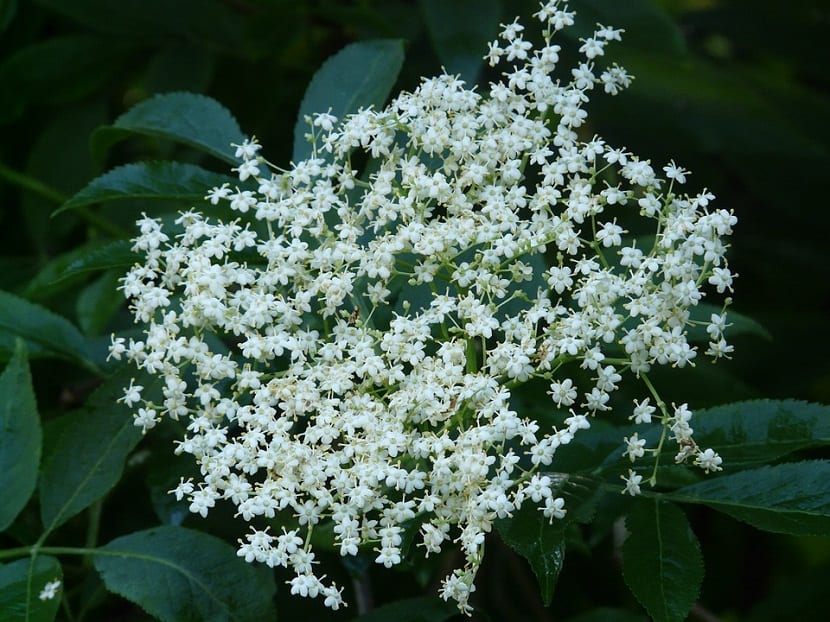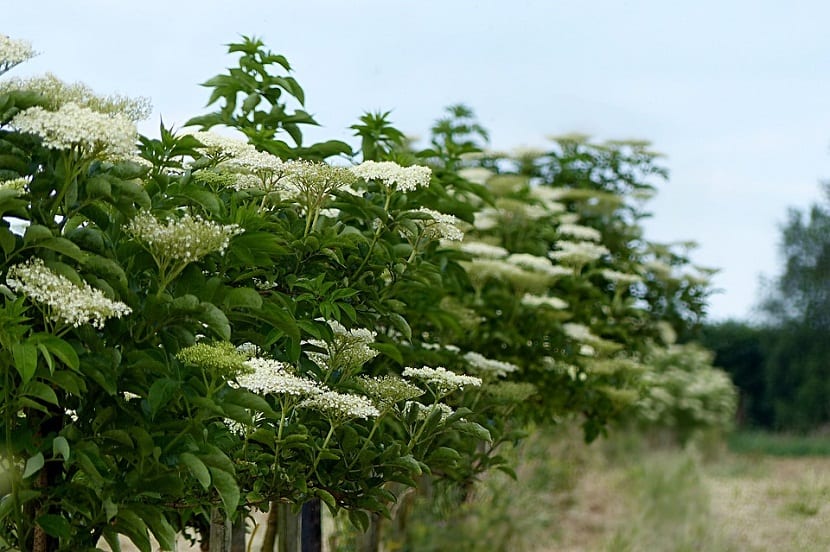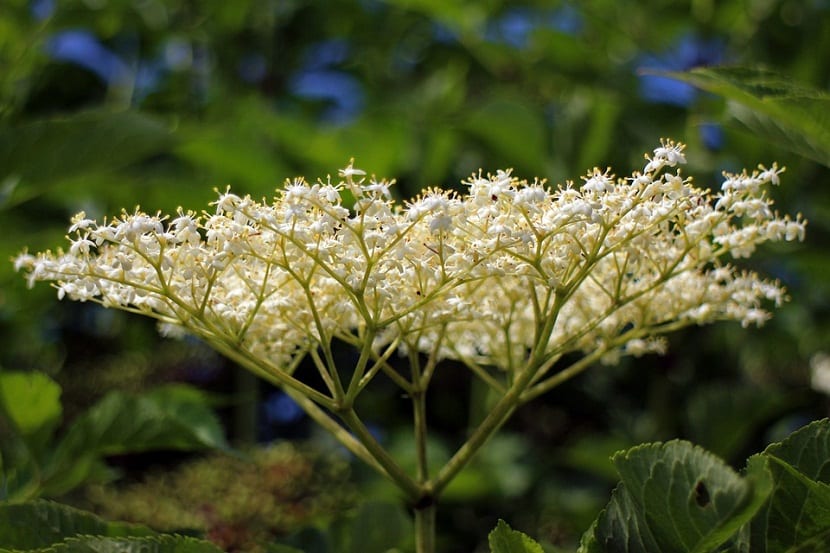
Its botanical name is Sambucus nigra L, belonging to the Caprifoliaceae family, which includes shrubs, trees or lianas.
Elderberry it is also known by other common names like the sabuco, sabugo, sayugo, linsusa, canillero and cañilero. We can say that this is a tree native to Europe and that it was introduced by the Spanish who brought it to America in the XNUMXth century.
Elderberry Characteristics

El Elder It has two subspecies, the Sambucus peruviana and the Sambucus mexicana. The name "Sambucus" comes from the Greek Sambuca, which It was a musical instrument used by the Romans and it was built with the wood of this tree, being the qualifier “nigra”, which refers to the black color of the ripe fruits.
It is a plant about 6 to 10 m high, its leaves are opposite, pinnate, very flexible and measure from 20 cm to 30 cm in length and have a regularly serrated edge. Its trunk is sloping, thick with rough bark and thick branches and the outer bark is cracked and ash brown in color.
The flowers are fragrant and grouped in terminal clusters of 15 called corymbs; each flower, hermaphrodite, has 5 star-shaped petals.
The fruits are fleshy, globose berries, measuring approximately 9 cm in diameter, they are juicy and edible. From its fruit a reddish to blackish tint is obtained when it is ripe and, on the contrary, when it is immature, the tint is blue, lilac or violet, with 3 to 5 seeds each.
The parts that have medicinal and food functions are the flowers and ripe fruits. Caution should be exercised with Elderberry because its bark, leaves, seeds and immature fruits can become poisonous.
Cultivation and Harvesting of Elderberry
Elderberry fits very well in humid forest areas and resists strong frosts.
It can be propagated by seeds and by vegetative reproduction, it presents sexual hermaphroditism, so usually emit propagules in the most superficial roots for its multiplication. The most common form of reproduction is vegetative reproduction.
Spring is the best season for flower pickingTheir drying process is in the shade and they must be kept in a cool, dry and dark place, apart, the fruits must be collected when they are black hanging from the branches, that is at the end of summer or early autumn.
In the nursery abundant watering should be applied and keeping the substrate moist, but avoiding excesses. Sowing can be done directly in the batch or by transplanting seedlings from the nursery. A hole is made in the ground according to the size of the bag that was used in the nursery.
Composition, uses and properties

Elderberry It is cultivated for ornamental, food, artisanal and medicinal purposes in temperate and cold climates.
Ripe fruits or berries are made up of organic pigments, anthocyanins, fiber, phosphorus, glucose, fructose, and potassium. Each 50 g of fresh fruit provides between 9-13 mg of vitamin C and 32.5 mg of Vitamin B. It has magnesium, zinc, iron and calcium.
They are edible wild fruits, both the skin and the pulp can be eaten. Jams are made with the fruits and they are also used for medicinal uses in syrups, laxatives and cleansers, to reduce cholesterol and improve vision, it also has useful anti-inflammatory properties for neuralgia, headache, abdominal pain and sciatica.
Recommended cook the berries even a little, to improve its flavor and to improve digestion.
The syrup can be prepared as follows:
The juice of the ripe fruit is extracted or squeezed and the seeds are strained, be careful with the seeds since they are toxic, and then leave cook for about 10 minutes, when cooling it is packaged and kept refrigerated. Take 2 to 3 tablespoons a day.
Research carried out at the University of Graz in Austria, found that the extract of the berry, reduces the oxidation of low-density lipoproteins of cholesterol involved in atherogenesis, which helps fight cardiovascular diseases.
On the other hand, green fruits contain a toxic principle called sambunigrina, which is why should not be eaten until well ripe. Likewise, this toxic principle is presented by the leaves, bark and seeds of the elderberry.
The leaves should not be consumed since they are highly toxic and in relation to their uses, it has been observed that in crops repel mice, moles and vermin, likewise, burns are an effective insecticide.
In infusion can be used as a mosquito repellent and sprayed on plants serves as protection against aphids and caterpillars.
For pest control, the preparation can be done as follows:
One liter of water and 225 g are boiled. of elderberry leaves for 20 minutes, strain and let cool, then add a teaspoon liquid or powder detergent and finally it is placed in an atomizer.
The flowers are edible, are used in gastronomy to flavor and prepare in various ways in herbal teas, jellies, jams, ice cream, cookies or in combination with other herbs. Wine has long been obtained, where macerated gives it an aromatic smell and old flavor.

The flowers are made up of essential oil, flavonoids, phenolic acids, tannins, vitamin C, and minerals. They have diaphoretic properties and they act on the bronchial epithelium, exerting an irritant effect that increases the production of bronchioalveolar secretions, which is why it is used effectively for the treatment of the common cold and anti-flu processes.
Studies have determined that elderberry flavonoids have antioxidant, anti-inflammatory and immunological properties, since these help to increase the production of cytokines in monocytes, thus stimulating the immune system.
The flowers can be used for manufacture of cleansing creams and remove blemishes on the skin.
The flowers and fruits have antiseptic and bactericidal properties, are used for pyorrhea, gingivitis and pharyngitis, with the infusion you can perform mouthwashes and gargles. They serve to disinfect wounds or relieve burns.
Flowers are traditionally attributed a galactogogue effect, that is to say that stimulates milk production due to its protein balance, which contributes to lactation.
Elder wood is quite resistant, highly valued for cabinet making and agricultural tool making. Due to the ease with which the pith is extracted from the branches, they are used for the manufacture of flutes, canutillos, blowpipes and for firewood.
Finally, the various uses mentioned above make it possible to verify that el Elder has traditionally been used for multiple purposes. As can be seen, all parts of the tree have characteristics with great potential to be used by humans.